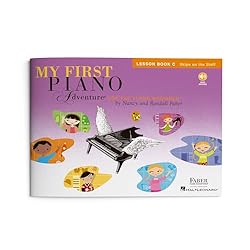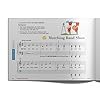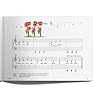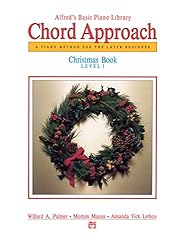Table of Contents
Learning Piano with a Minimalist Approach
Embracing a minimalist approach to learning piano focuses on simplifying the process to the essential elements, enabling efficient learning and progress. This method not only reduces overwhelm by eliminating unnecessary clutter and complexity but also enhances focus on the fundamental concepts and techniques that yield the most substantial gains. Key benefits include streamlined practice sessions, a deeper understanding of music theory, and a more enjoyable learning experience. Dive into a minimalist journey to master this beloved instrument with clarity and purpose.
Starting with the Basics: What You Really Need to Know
When embarking on learning piano with a minimalist approach, it’s crucial to focus on the core elements that facilitate effective learning without overwhelming yourself with too much information or too many materials. Here are the key basics:
My First Piano Adventure: Lesson Book C | Beginner Piano Method Book | Learn Skips and Early Staff with Online Audio | Piano Sheet Music Songbook | Faber Piano Book for Kids
Alfred's Basic Chord Approach Christmas, Bk 1: A Piano Method for the Later Beginner (Alfred's Basic Piano Library, Bk 1)
$6.99 (as of November 22, 2025 23:22 GMT -08:00 - More infoProduct prices and availability are accurate as of the date/time indicated and are subject to change. Any price and availability information displayed on [relevant Amazon Site(s), as applicable] at the time of purchase will apply to the purchase of this product.)Alfred's Basic Adult Piano Course: Lesson Book, Level One
50% OffPiano: Learn The Piano in 5 Easy Steps: A Self-Guided Piano Course for Beginners (with Online Video Instruction - Piano Learning Books for Beginning Piano Players)
17% OffFirst and foremost, familiarize yourself with the piano keyboard layout. Recognize the pattern of black and white keys, and understand how these keys correspond to different notes. Knowing how to navigate the keyboard confidently is fundamental before delving into more complex aspects of piano playing.
Learning some basics of music notation is essential. Focus on understanding musical staff, clefs, and note values. This will help you read simple sheet music, which is crucial for progressing beyond the very basics.
Practicing scales is instrumental in developing finger strength and familiarizing yourself with the sound and structure of various keys. Start with major scales such as C Major since it involves only white keys and gradually include more complex scales.
Learn a few basic chords and simple chord progressions. Understanding chords and how they transition between each other equips you to play a wide variety of music and assists with improvisation skills.
P71 Digital Piano Review and Guide
$0.00 (as of November 22, 2025 14:40 GMT -08:00 - More infoProduct prices and availability are accurate as of the date/time indicated and are subject to change. Any price and availability information displayed on [relevant Amazon Site(s), as applicable] at the time of purchase will apply to the purchase of this product.)Wicked - A New Musical Songbook by Stephen Schwartz | Piano Vocal Selections with 13 Broadway Hits | Sheet Music for Piano Voice and Guitar | Authentic Arrangements for Performers Students and Fans
31% OffReady for Theory Level 3 Piano Review Book (Ready for Theory Piano Review Books)
$12.95 (as of November 22, 2025 14:46 GMT -08:00 - More infoProduct prices and availability are accurate as of the date/time indicated and are subject to change. Any price and availability information displayed on [relevant Amazon Site(s), as applicable] at the time of purchase will apply to the purchase of this product.)The Piano Proficiency Exam Review Book
$14.57 (as of November 22, 2025 14:43 GMT -08:00 - More infoProduct prices and availability are accurate as of the date/time indicated and are subject to change. Any price and availability information displayed on [relevant Amazon Site(s), as applicable] at the time of purchase will apply to the purchase of this product.)Developing a good rhythmic sense is crucial. Begin with simple time signatures like 4/4 and practice tapping rhythms with your hands. This basic ability will significantly enhance your timing and coordination on the piano.
Establish a consistent practice routine. Short, focused sessions on a regular basis are more effective than sporadic, lengthy sessions. Aim for at least 15-30 minutes a day when starting out.
Develop your ear by listening to a lot of piano music and trying to play by ear. This enhances your musical intuition, which is invaluable for playing more expressively and spontaneously.
In the spirit of minimalism, limit your learning tools. Focus on a few quality resources like a good beginner’s piano book, free online tutorials, and simple tools like a metronome. Avoid cluttering your learning with too many gadgets or overly complex software.
Focusing on Essential Techniques and Skills for Learning Piano with a Minimalist Approach
Fundamental Piano Techniques
Posture and Hand Position: The foundation of effective piano playing starts with correct posture and hand positioning. Keep your back straight, feet flat on the floor, and wrists flexible to prevent strain or injury.
Scalable Finger Exercises: Start with simple scales and arpeggios to build finger strength and independence. Practice slowly at first to ensure accuracy before increasing speed.
Essential Musical Concepts
Rhythm and Timing: Master basic rhythmic patterns using a metronome to keep timing consistent. Clapping and tapping rhythms before playing them on the piano can also be beneficial.
Understanding Harmony: Begin with learning primary chords (major, minor, dominant) and progress to more complex structures like seventh chords and chord inversions.
Minimalist Learning Strategies
Focused Practice Sessions: Limit practice sessions to effective 30-40 minute segments concentrating on one or two areas for improvement. Set clear, achievable goals for each session.
Simplicity in Repertoire: Select pieces that reinforce the fundamental techniques and skills, rather than tackling overly complex compositions too soon.
Utilizing Technology
Metronomes and Apps: Use a metronome app to aid in timing and rhythm training. Other apps can offer interactive lessons and exercises which adapt to your skill level and pace.
Video Tutorials: Leverage online video platforms to observe and learn from skilled pianists. Pay attention to their techniques, and try to apply these observations during practice.
Reflective Practice
Self-Evaluation: Regularly record your practice sessions and listen critically to identify areas for improvement. Reflect on your progress and adjust your practice routine accordingly.
Seeking Feedback: Whenever possible, get constructive feedback from more experienced pianists or teachers who can provide insights and recommendations to enhance your skills.
Simplifying Music Theory for Beginners: Learning Piano with a Minimalist Approach
The first step in learning piano with a minimalist approach is to focus on basic musical concepts essential to playing the piano. Start by learning the musical alphabet (A to G), which repeats across the keyboard. Understand whole and half steps and how they form scales, with a particular focus on major and minor scales as they form the foundation for most pieces.
Concentrate on recognizing key signatures and the scales that correspond to them. For minimalists, mastering C Major as a starting point allows for an easier understanding of piano geography because it uses only the white keys. Then gradually learn other major scales, such as G, D, and F, as well as their relative minors (E minor, B minor, and D minor).
Focusing on chords, start with learning simple triads (three-note chords). The primary chords in any key are the I (one), IV (four), and V (five) chords. For instance, in C Major, these would be C major, F major, and G major, respectively. Understanding these chords and practising chord progressions in these keys can help you accomodate many songs.
For a minimalist approach, develop the skill of playing by ear. This involves recognizing pitches and patterns by listening and then applying them directly to the piano. Begin with simple melodies and then move to more complex tunes. Alongside, learn basic improvisation techniques starting with the scales and chords you’ve mastered. Experiment with different rhythms and motifs within these confines.
Grasping basic rhythms and meter is crucial. Understand the value of notes (whole, half, quarter, etc.) and rests, and how they fit into measures with different time signatures like 4/4 or 3/4. Practising with a metronome can solidify your timing, a vital skill for playing any musical piece efficiently.
How to Learn Piano with Limited Time and Resources
Learning piano doesn’t require endless hours or a grand budget. With a minimalist approach, you can efficiently learn to play the piano with limited time and minimal resources. Here are several focused strategies to help you succeed:
Choose the Right Learning Tools
Start by selecting a compact keyboard if a traditional piano is out of reach, financially or spatially. Many keyboards come with weighted keys and offer a range of sounds and features that mimic those of an acoustic piano. Optimize costs by looking for second-hand options or consider renting instruments.
For learning resources, utilize free or inexpensive apps and online tutorials. Apps like Simply Piano, Flowkey, or Yousician cater to those with tight schedules by offering bite-sized lessons that progressively teach piano fundamentals and techniques.
Establish a Practice Routine
Time constraints mean you need a structured practice routine. Allocate a specific, consistent time slot each day to practice, even if it’s just 15-30 minutes. This consistency builds muscle memory and ingrains the learning deeper.
Focus on Fundamental Skills
With limited time, it’s crucial to focus on fundamental playing skills. Prioritize learning scales, chords, and simple pieces that incorporate both. This not only enhances your understanding of music theory but also broadens your ability to learn more complex pieces later on.
Utilize Smart Practice Techniques
Make the most of your practice sessions by using techniques like slow practice, where you play notes slowly to avoid errors and ensure quality. Focus on small sections of music at a time, gradually building up to the full piece.
Record and Analyze Your Playing
Recording your sessions helps critique your own playing and progress. Listen back to your recordings to identify areas for improvement and validate areas where you’re succeeding. This feedback is crucial for effective self-directed learning.
Stay Motivated and Set Realistic Goals
Keeping motivation high is key, especially with resource constraints. Set small, achievable goals such as mastering a particular scale or piece within a certain timeframe. Celebrate these milestones to fuel your motivation.
Simplify Sight Reading
While complex pieces may not be realistic early on, simplifying sight reading can help you progress. Focus on reading simple music scores and improving your ability to recognize notes and rhythms quickly. This skill is invaluable and will serve you throughout your piano learning journey.
Connect with Other Learners
Join online communities, forums, or social media groups where you can connect with other piano learners. These communities provide moral support, tips, and sometimes shared resources that can be extremely helpful.
Practicing Piano Without a Full Instrument
For individuals who do not have access to a full piano, there are several creative ways to practice and improve skills effectively. These methods leverage technology and innovative tools to mimic the experience of playing on a traditional piano.
Using Keyboard Apps
Digital applications for smartphones and tablets can simulate a piano keyboard. These apps often provide a range of features such as adjustable octaves, different sounds, and even teaching modules. Apps like Perfect Piano or Simply Piano offer interactive lessons and are suitable for both beginners and seasoned players. This approach is highly portable, meaning practice can happen anywhere and at any time.
Electronic Keyboards
An alternative to a full-size piano is an electronic keyboard. These instruments vary in size, with options from 25 to 88 keys. For those practicing piano, it is recommended to choose a keyboard with at least 61 keys to allow for a broader range of piano pieces to be played. Keyboards also often feature volume control and headphone outputs, making them ideal for quiet practice sessions.
MIDI Controllers
MIDI controllers paired with computer software can also serve as a practical tool for piano practice. They do not generate sound on their own but send signals to a computer which then generates musical sounds. When used with software like GarageBand or Ableton Live, these controllers can emulate a variety of piano sounds and other instruments. Additionally, many MIDI controllers are compact and portable, providing flexibility in practice locations.
Rubber Keyboards and Roll-Up Pianos
For those with very limited space, rubber keyboards or roll-up pianos present a unique alternative. These devices can be spread out on any flat surface and rolled up for easy storage. While they do not offer the same feel as traditional keys, they are an affordable and space-saving solution that can still support finger positioning and timing skills.
Silent Pianos
Silent pianos are real acoustic pianos equipped with an option to silence the strings and instead play digital sounds through headphones. This allows for the feel of a real piano while practicing silently. This is beneficial for apartment dwellers or those needing to keep noise to a minimum.
Conclusion
Adopting a minimalist approach to learning the piano focuses on simplicity, allowing students to concentrate on essential skills without being overwhelmed. This approach not only fosters a deeper understanding and appreciation of music but also ensures a more structured and relaxing learning experience. It effectively reduces the risk of burnout and builds a solid foundation for future advanced studies. Overall, minimalism in piano learning promotes a more joyful and sustainable musical journey.
































